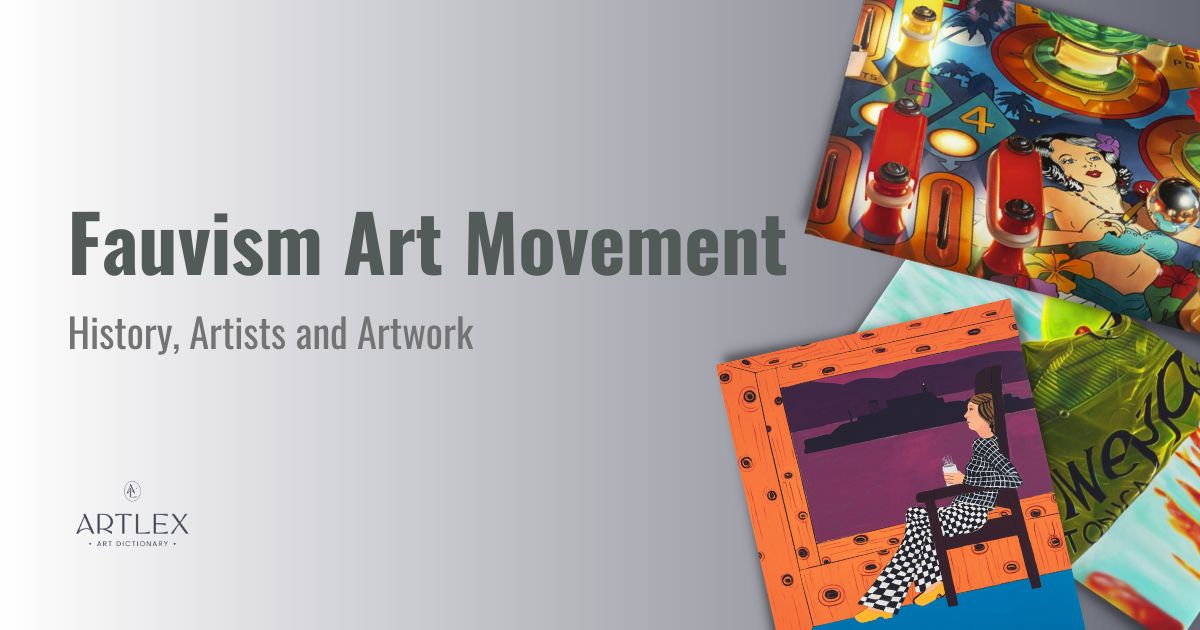What is Fauvism?
Fauvism was an art movement that flourished in France from 1905 to 1908. It was led by Henri Matisse (1869 – 1954) and André Derain (1880 – 1954). Other important Fauvists were Maurice de Vlaminck, Henri Charles Manguin, Othon Friesz, Kees van Dongen, Georges Braque, and Raoul Dufy. Their work was characterized by painterly qualities, a saturated color palette, and simplified forms. Pure, vivid colors were fiercely applied to the canvas with short brush strokes, providing a strong and immediate visual impression of the work. The name Fauvism comes from a derogatory comment of art critic Louis Vauxcelles after he saw paintings by Matisse and his fellow artists at the 1905 Salon d’Automne in Paris. Vauxcelles described their works and the unconventional use of paint and brushwork akin to the “wild beast” (“les fauves” in French).
Notable Fauvist Artworks
- George Braque, Seascape. L’Estaque, 1906, The Thyssen-Bornemisza National Museum, Madrid, Spain
- George Braque, The Large Trees. L’Estaque, 1906-07, The Museum of Modern Art, New York City, US
- Henri Matisse, Woman with a Hat, 1905, San Francisco Museum of Modern Art, San Francisco, US
- Henri Matisse, Le Bonheur de Vivre (The Joy of Life), 1905-06, Barnes Foundation, Philadelphia, US
- Henri Matisse, Portrait of Madame Matisse (The Green Stripe), 1905, National Gallery of Denmark, Copenhagen, Denmark
- André Derain, The Turning Road, L’Estaque, 1906, The Museum of Fine Arts, Houston, US
- André Derain, Bridge over the Riou, 1906, The Museum of Modern Art, New York City, US
- André Derain, Charing Cross Bridge, London, 1906, The National Gallery of Art, Washington, US
- André Derain, Fishing Boats, Collioure, 1905, The Metropolitan Museum of Modern Art, New York City, US
- Maurice de Vlaminck, The River Seine at Chatou, 1906, The Metropolitan Museum of Modern Art, New York City, US
- Maurice de Vlaminck, Barges on the Seine, 1905-06, The Pushkin State Museum of Fine Arts, Moscow, Russia
- Kees van Dongen, Modjesko, Soprano Singer, 1908, The Museum of Modern Art, New York City, US
- Othon Friesz, Landscape at La Ciotat, 1907, Musée d’art moderne de Troyes, Troyes, France
- Othon Friesz, Landscape at La Ciotat, 1907, Musée d’art moderne de Paris, Paris, France
Characteristics of Fauvism
Initially, Fauvism was inspired by the Post-impressionism of Van Gogh and Paul Cézanne and the Neo-impressionism of Seurat and Signac. The Fauvists adopted their painterly approach to painting directly from nature and their extensive use of complementary colors. However, unlike their predecessors who were engaged in the color theory exploring optical effects of colors, the Fauvists were less interested in science and representation and more in communicating the artist’s emotional response to subjects through color. They experimented with the expressive potential of color using bright, unblended colors applied thickly to the canvas, often directly from the paint tube, in an arbitrary manner with spontaneous, short brush strokes. They simplified forms and distorted perspectives creating a new pictorial space that was defined by anti-naturalism.
Matisse and Derain introduced this new painterly approach in the summer of 1905 while working together in a small village called Collioure in the South of France. They exhibited their works at the Salon d’Automne in Paris the same year and shocked the visitors with the new painting style. On this occasion, the term “fauves” was first used by Louis Vauxcelles to describe the unconventional art he saw. Although derogatory, the painters proudly accepted the name.
Fauvism’s Contribution to Modern Art
Fauvism was the first of the avant-garde movements of the twentieth century that pushed art away from naturalistic representation. Fauvists separated color from its descriptive purpose and instead emphasized its emotional value, allowing it to exist as an independent element within the painting without being true to nature. They were also one of the first painters to make a move towards abstraction. These developments paved the way for a series of subsequent art movements such as Cubism, Expressionism, and Abstract Art. After 1908, some of the Fauvists, like Braque and Derain, headed towards Cubism, while Vlaminck turned to Expressionism. Only Matisse, the leader of the movement, remained faithful to the Fauvist sensibility for the rest of his career.
Notable Fauvists
- Albert Aurier (1865–1892)
- Albert Gleizes (1881–1953)
- Albert Marque (1872–1939)
- Albert Marquet (1875–1947)
- Alice Bailly (1872–1938)
- Amedeo Modigliani (1884–1920)
- André Derain (1880–1954)
- André Lhote (1885–1962)
- Béla Iványi-Grünwald (1867–1940)
- Charles Camoin (1879–1965)
- Ernst Ludwig Kirchner (1880–1938)
- Eugène Carrière (1849–1906)
- Francis Picabia (1879–1953)
- Georges Braque (1882–1963)
- Georges Rouault (1871–1958)
- Gustave Moreau (1826–1898)
- Henri Manguin (1874–1949)
- Henri Matisse (1869–1954)
- Henri Ottmann (1877–1927)
- Henriette Tirman (1875–1952)
- Ion Theodorescu-Sion (1882–1939)
- János Mattis-Teutsch (1884–1960)
- Jean Dufy (1888–1964)
- Jean Metzinger (1883–1956)
- Jean Puy (1876–1960)
- Julian Hatton
- Karl Schmidt-Rottluff (1884–1976)
- Kees van Dongen (1877–1968)
- Louis Valtat (1869–1952)
- Maggie Laubser (1886–1973)
- Marc Chagall (1887–1985)
- Marcel Mouly (1918–2008)
- Maurice de Vlaminck (1876–1958)
- Mildred Bendall (1891–1977)
- Nadežda Petrović (1873–1915)
- Othon Friesz (1879–1949)
- Paul Gauguin (1848–1903)
- Paul Ranson (1861–1909)
- Paul Sérusier (1864–1927)
- Paul Signac (1863–1935)
- Raoul Dufy (1877–1953)
- Robert Antoine Pinchon (1886–1943)
- Robert Delaunay (1885–1941)
- Russell T Clement
- Sonia Lewitska (1880–1937)
Related Art Terms

